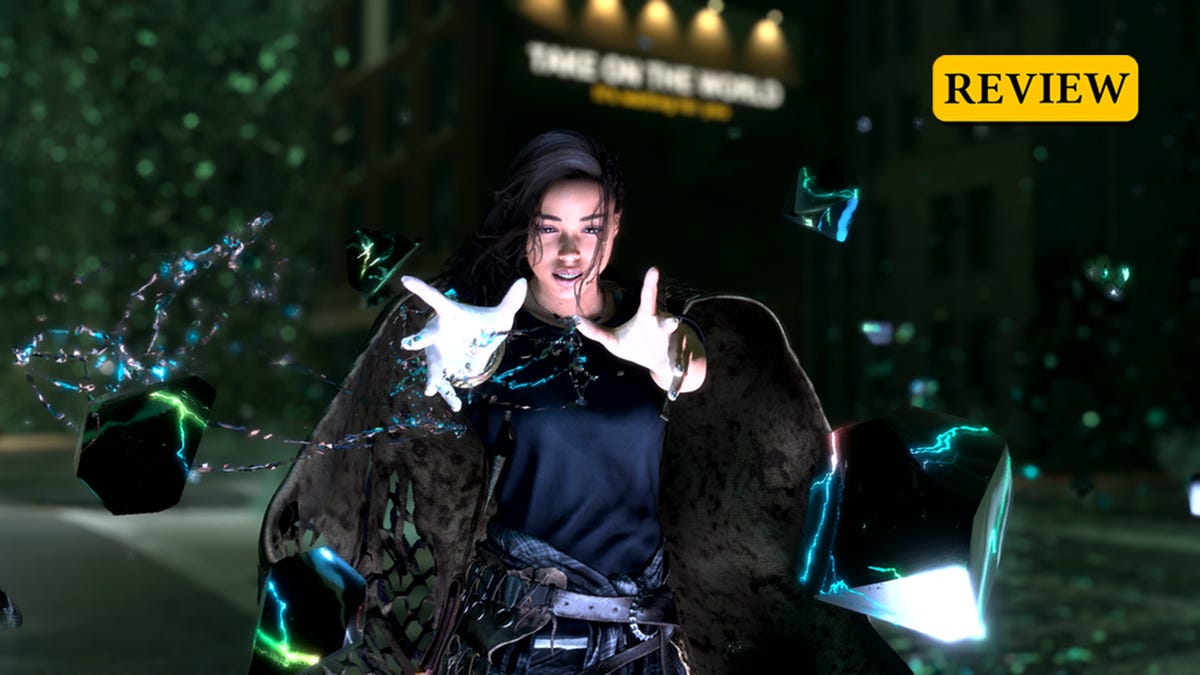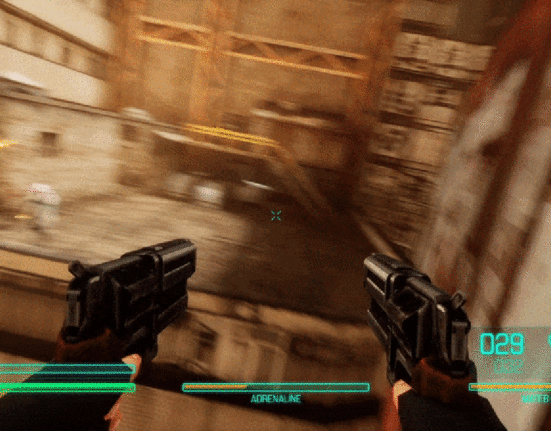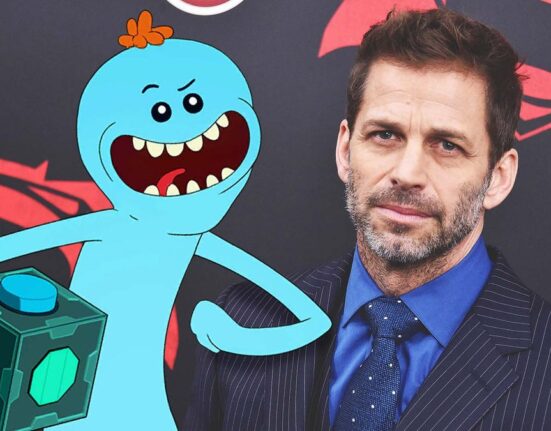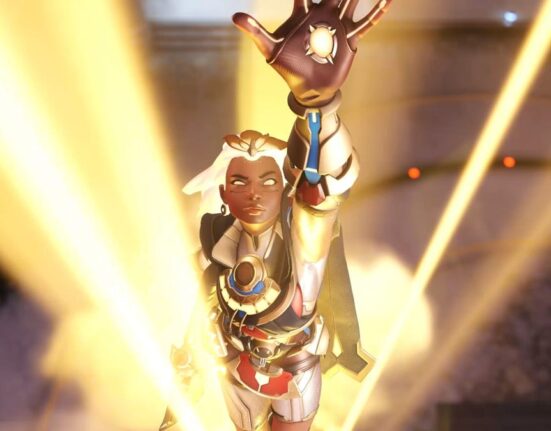Forspoken is a painfully flawed game. With a variety of rampant inconsistencies, its stilted presentation belies a gem of a story that centers women and feminine expression. In some ways that makes Forspoken a welcome breath of fresh air for fantasy games, as its 15 to 20 hour open-world campaign follows a woman of color who not only must overcome a great fantastical evil, but must also overcome the effects of life-long trauma and marginalization. Given its many technical flaws, Forspoken is a tough game to recommend, but its story pays off with a wonderful protagonist who exists in a world full of narrative twists and turns.
Released on January 24 of this year, Forspoken comes courtesy of publisher Square Enix and developer Luminous Productions. The game is an open world action-RPG that follows Alfrey “Frey” Holland as she is warped from her hometown of New York City to the fantastical realm of Athia, where she is tasked with fighting off an evil force encroaching on the last human city. The subject of many jokes and much head-scratching over its polarizing, non-stop dialogue and uncomfortable character animations, Forspoken was likely dead on arrival for many. And sure, it can sometimes feel clumsy as it tries to pitch a story about reclaiming a shattered matrilineal heritage.
Forspoken is a game that’s sorely vulnerable to being taken out of the context of its genre, isekai, and its own story, which gets obfuscated by frustrating technical issues and potentially abrasive dialogue too early on. If you’re not familiar with isekai, I’ll briefly turn it over to the otaku of Kotaku, Isaiah Colbert, to break it down:
An isekai, which literally translates as “different world” or “otherworld,” is a genre of storytelling typically found in anime like Sword Art Online and The Jobless Reincarnation. The usual structure of an isekai story revolves around its main character getting teleported into a new world. Usually that world has a high fantasy aspect to it. Upon arriving in the new world, isekai protagonists are entrusted with defeating a great evil that plagues the realm with the help from an unlikely ally. While some isekai like Re:Zero play their premise straight, other shows like Konosuba will have their wayward hero quip about the ridiculousness of their situation while taking the piss out of the world’s fantasy conventions. Isaiah Colbert, Staff Writer.
Alice in Wonderland is a fair Western analog, and is in fact referenced in Forspoken itself. The genre of this game’s story rests on the rupturing of worlds, of smashing together characters and settings wildly out of time and place. As such, I don’t think there’s any way to tell a story like this without a few odd beats or two. Forspoken doesn’t always nail this transition well, despite the genre containing some inherent dissonance. But if you can handle the dialogue, I think there’s enough of an entertaining story here to keep you hooked.
An orphan with no knowledge of her parents, Frey has spent 21 years in a New York City that constantly confronts her with an all-too-eager-to-punish justice system. The opening scenes see Frey spared from a “three strikes rule” because of a judge, also a woman, who clearly believes Frey is capable of improving her life and ought to be given that chance. Not long after, she discovers a magical, talking bracelet she names “Cuff,” and she’s then whisked away to the fantastical realm of Athia with no real way to return.
Frey learns that a corruptive force that transforms people and wildlife into monsters is spreading all throughout Athia, seemingly because of four fallen female rulers known as “Tantas.” It’s here that the game becomes an obvious “go stop the evil people!” narrative. But as the story continues, and the struggles become too much for Frey to emotionally handle, that’s when the wisecracking drops and we see a young woman who believes herself to be unworthy of love. Her early missteps in Athia seem to only reinforce her internalized trauma.
More than any lore dive into Athia and the Tantas and how they went mad, a driving conflict throughout Forspoken is Frey’s struggle with herself. And it’s for this reason that, aside from the banter that repeats during combat (which, though repetitive, is no worse than what I’ve heard in other JRPGs and can be turned down in the settings), I never took issue with the dialogue in Forspoken. And its setting of Athia is a wonderful mirror image of Frey’s own life and struggles in New York City. Frey is a consistent and believable character, one whose struggle with a complicated life is deserving of empathy; and depending on your own experience in life, you will find yourself empathizing with her. Sadly, bite-sized trailers and initial impressions don’t immediately reveal this. But her central struggle, and the revelations she learns along the way, are rewarding to follow through with.
Sound exciting? Well, hold your horses. Forspoken has many elephants in the room that we need to address. One of the clearest is how inconsistent the visual quality of this game is across the board. Despite elegant combat, parkour animations, and gorgeous displays of particle effects for its magic, Forspoken often looks like a remastered PlayStation 3 game. Environments, particularly city areas, are painfully bland by today’s standards, and they stand out even worse alongside the otherwise very elaborate clothing and jewelry models on characters.
Facial animations are inexcusably jarring. It sometimes looks like these characters are struggling to phrase the very words they’re saying. Frey is no exception here, and this sours her excellent voice acting and dialogue. In general, the audio feels out of step with what’s on-screen. This disconnect starts early on with a shot of Frey walking through a building wearing sneakers, yet we hear the sound effects of shoes with hard soles. It’s a sign of what’s to come. Cutscenes sometimes exhibit weird pacing, fading to black at odd moments; characters stand around lifelessly at times, and there’s often a dramatic disconnect between the impact of the vocal performances and how characters move, gesture, or express emotion on their faces. It feels like multiple elements of this game were developed at different times with little attention to bringing it together as a cohesive presentation.
The audio in general is a colossal mess. The music soars too loudly far too often. Sound effects and dialogue clash in deeply unpleasant ways that kind of demand you turn on subtitles whether you were going to or not. You should definitely lower the volume of the music and sound effects to try and balance this out.
And technical issues don’t stop there. Running on the Luminous Engine, Forspoken drops frames constantly—even in “Performance Mode” (which is still the only setting to consider unless you have a 120hz, variable refresh rate-compatible television on PS5). Technical bugginess also isn’t something you can power through on the PC version, which not only runs just as bad, but has remarkably high system requirements for average performance.
The bad performance has the effect of making the game look unpleasant, but it also screws with the combat. Though Forspoken has a wide number of spells and combat mechanics to play around with, I would often fall out of pace with the action, struggling to get spells to activate right (particularly the more powerful attacks that charge up and require you to press both L2 and R2 at the same time), and after about 20 hours into the game, my suspicion is that this has something to do with the frame rate. It’s hard to tell, but the poor technical performance just creates a murky presentation where it’s not always clear what’s going on or why you weren’t able to do what you wanted to do. Precise action is difficult when the audio cues are slightly off, and the framerate feels wildly unpredictable far too often.

But when the combat does work, which, to be fair, is most of the time, it provides some of the most exciting movement mechanics I’ve played with since inFamous Second Son and First Light. Luminous Productions has managed to capture the exhilaration of wild, aerial maneuvers and combat of the kind we’ve seen in films like Advent Children or Kingsglaive: Final Fantasy XV. And it’s all distilled into easy-to-use controls that make you feel like an absolute badass of a sorceress, deftly dodging attacks and zipping past your enemies to deliver epic final blows, all filled with the actual strengths of the Luminous Engine’s lighting and particles. When it all comes together, there’s not much else to compare it to.
As an open-world game, Forspoken is filled with your usual busywork. You can take on seemingly irrelevant sidequests, or “Detours,” in the main city hub. You can take on dungeons with challenging enemies to earn better gear, clear out areas to earn new nail polish that offers different buffs, and more. Like most open-world games, it feels a little hollow and it’s disappointing that really the only thing you do in the game is fight and that everything that moves in this sometimes very pretty world is just a target to attack. This got particularly arduous toward the end where I felt the conclusion was held behind just a few too many frustrating brawls with bosses.
But the core narrative story isn’t terribly long. In fact, it manages to work comfortably for a fantasy epic without getting tiring. And it does a good job of telling you when you’re going to progress the story further, meaning that if you want to drop back and pick up a bunch of sidequests and grind out your magic so its more powerful, you have clear cues when you should do so.

But what I kept returning to in Forspoken was just how wonderful it was to play a fantasy game that centers women so directly, both with the protagonist and many non-player characters. In fact, I can’t recall a single scene where just two men speak to one another. It’s a story about a woman who must overcome the burdens society has shackled her with, which do more damage than any fantastical force of evil and is something that all women know too well. It allowed me to feel a resonance with this story and this character in a way that is painfully uncommon. It’s just such a shame that this game doesn’t have a more solid, consistent presentation.
Somewhat atypical for many Square Enix presentations, the game’s narrative is coherent, direct, and unburdened with excessive made-up language and fictional historical events that don’t give many reasons for emotional investment. When the hidden layers of the narrative began to reveal themselves after I defeated the game’s second main boss, I was invested the whole ride through.
Forspoken deserves better than what shipped on January 24. The strength of its story and protagonist do outpace its many problems, but much like Frey’s early struggles in seeing her own greatness, it’s clouded by unfortunate circumstances.







Leave feedback about this